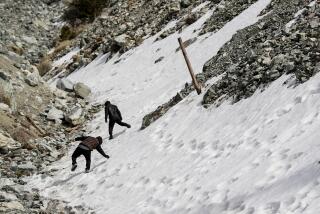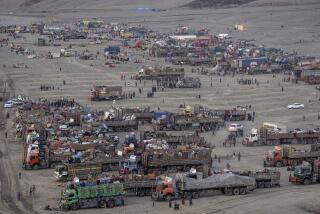For troops on Siachen Glacier, the elements are the enemy
RAWALPINDI, Pakistan — Icy wind whipped Lt. Nauman Ahmed’s face as he plodded up a barren expanse of snowfields and crevasses. Woozy and spent, he reached a Pakistani military outpost 20,000 feet above sea level and slumped down on a cot in one of the camp’s fiberglass igloos.
The next morning, the peril of waging war in the world’s highest conflict zone began to take its toll. His head throbbed, and he was coughing up blood. When he tried to speak, he couldn’t form words.
“I thought to myself, ‘What is happening to me?’” Ahmed, now 30 and a retired captain, says eight years later. “It’s such a difficult place to live.... On Siachen Glacier, we never know whether we will be around the next day.”
Ahmed survived his deployment to the 49-mile-long no-man’s land wedged into the Himalayas, but he isn’t the same man. Cerebral edema brought on by the lack of oxygen left him with lasting brain damage. When he speaks, his words come slow and measured. Simple tasks like noting a cellphone number pose a challenge.
“People have to speak slowly to me,” he says. “Like with numbers, I have to think, ‘Zero — what is zero?’”
When the veterans of Pakistan’s 28-year standoff with India atop the glacier in the disputed Kashmir region tell their war stories, they don’t speak of assaults on hilltop bunkers or lightning raids to outflank the enemy. They speak of comrades with limbs black with frostbite, fruitless searches for soldiers buried under avalanches, the battle to survive in a place where wind howls at 100 mph, snow piles up 50 feet deep and the temperature plunges to minus-50.
The massive avalanche that buried 129 soldiers and 11 civilians in a 200-foot-deep tomb of ice and snow April 7 has renewed a question that Siachen veterans have ruminated on for years: Why do India and Pakistan continue to devote manpower and millions of dollars to a war over an uninhabited glacier?
“We’d push them off a peak, then they’d push us off a peak, but nothing significant happened,” said Ali Kuli Khan Khattak, a retired Pakistani general who commanded forces in Siachen and the rest of far northern Pakistan in the late 1980s and mid-1990s. “So take it from me, it’s one of the most futile things to do. No war is very clever, but this one probably takes the cake.”
No one knows the futility of the Siachen conflict more than the veterans who served there. More than 3,000 Pakistani soldiers have died since the conflict began in 1984, and most of those deaths were the result of weather conditions rather than combat. No significant territory has been taken by either side. Skirmishes almost always involved sporadic exchanges of small-arms fire or a spate of artillery shelling.
Since 2003, a cease-fire has made deployment on Siachen seem a purposeless exercise in subzero survival.
The conflict reflects the intense animosity that has poisoned Pakistani-Indian relations since the end of British colonial rule on the subcontinent led to the partition of India and each country’s independence in 1947. India and Pakistan have fought three wars in six decades, and both countries now have nuclear arsenals.
The Siachen conflict has its roots in a 1984 incursion by Indian troops into a section of Kashmir, a region claimed by both India and Pakistan and the focus of two of their three wars and one smaller military conflict.
For most of Kashmir, a Line of Control demarcates the areas administered by each country. But that line stops roughly 40 miles south of Siachen. India’s troop movement onto the glacier prompted Pakistan to reciprocate with its own deployment, and the standoff endures.
The dangers Pakistani and Indian soldiers face on Siachen mirror those mountaineers encounter when tackling Everest. At 20,000 feet, the oxygen level is about half that at sea level. The air is so cold that bare skin can bind to steel within seconds. Yawning crevasses make trekking from post to post treacherous. In avalanche-prone areas, soldiers limit hiking to nighttime, never in the morning or afternoon, when sunlight loosens massive walls of snow packed higher on the slopes.
Altitude sickness is an ever-present peril. A lack of oxygen can cause fluid to leak from capillaries and build up either in the brain (cerebral edema) or in the lungs (pulmonary edema). Both are life-threatening.
“You couldn’t stay there a long time, because of the lack of oxygen,” said Khalid Kuli Khan Khattak, Gen. Khattak’s son and a retired captain who spent a year at Siachen. “When you hiked, you had to acclimatize every 1,000 feet you go. Camp out a night, then go up another 1,000 feet.”
Nothing is easy on Siachen. The lack of oxygen makes cooking impractical, so soldiers mostly live on canned lentils. With no hot water, troops bath once a month in summer, and never in winter.
“And you’re wearing clothes for a month, without change,” Khalid Khattak said. “So lots of people would get lice.” After a few months, the soldiers’ goose-down parkas would blacken with soot from the kerosene stoves that heated their igloos.
Skirmishes with Indian troops happened fairly regularly when Khalid Khattak was deployed at Siachen in 1998. But they usually were brief exchanges. And there was an unwritten rule: Both sides relied heavily on military helicopters for everything from the replenishment of supplies to evacuation of injured or sick troops, so “most of the time, we wouldn’t fire at helicopters, and vice versa,” Ali Khattak said.
The real enemy, however, has always been Siachen itself. Retired Maj. Haroon Maqsood remembers a blizzard that swept through an outpost under his command in the winter of 1987. At the time, troops were housed in tents, not fiberglass igloos. Wind as high as 100 mph tore through the outpost, ripping the tents from their frames.
Seven soldiers were stranded on a snowfield, exposed overnight to the fierce wind and snow. By the time a rescue party arrived, five of the men were dead. Another man died at a hospital in the nearest town, Skardu. The seventh soldier, a captain named Zafar, survived, but severe frostbite forced doctors to amputate his arms at the shoulders and his legs at the knees.
“He was so depressed,” Maqsood said. “He was engaged to be married, but after this happened, the girl’s parents refused to marry their daughter to him.”
Ahmed could have staved off permanent brain damage had he descended sooner. But fearing being labeled a coward, he downplayed his symptoms to everyone — to a doctor at base camp who called the outpost daily to check on the condition of soldiers, to his commanding officer, even to his father, retired Lt. Col. Zulfiqar Ahmed, whom he called from the outpost.
“At that time, he sounded OK and never mentioned it to me,” said the elder Ahmed, seated next to his son during an interview at their home in the military city of Rawalpindi.
After a month at 20,000 feet, Ahmed’s condition worsened and he agreed to return to base camp. Doctors suggested that he be taken down by stretcher, but Ahmed insisted on walking. As he trudged down the slope accompanied by his men, the right side of his body grew numb. Farther down the slope, “I felt I could no longer control my legs.” So he began crawling.
About a mile into the hike, Ahmed couldn’t move anymore. His fingers were frostbitten, and doctors later would amputate the tips of three fingers on his right hand. One of his soldiers carried Ahmed on his back. He was taken to the army’s primary hospital in Rawalpindi, where doctors operated to drain the fluid pressing on his brain and relieve cerebral hemorrhaging.
Two months after the surgery, Ahmed was able to once again walk normally, and he recently began working as a security guard for a Pakistani oil company. He once dreamed of returning to his studies at an Islamabad university once he finished army service. Siachen, however, ended that dream.
After the April 7 avalanche, officials in Islamabad and New Delhi began questioning the need to deploy troops at Siachen.
During a visit to the region April 18, Pakistani army chief Gen. Ashfaq Kayani said it was time for Pakistan and India to resolve the Siachen conflict through dialogue. A day later, Indian State Minister for Defense Pallam Raju welcomed Kayani’s remarks. Keeping troops at Siachen “does take an economic toll,” Raju told the Times of India. “This money can be better spent on the development of both countries.”
So far, however, neither side has made any move toward a pullback. As recovery teams with bulldozers continue to churn up mounds of ice and snow in search of bodies, soldiers who once served on Siachen wonder what it will take to get both sides to withdraw.
“Unfortunately, this battle is being prolonged because of governments,” Ahmed said. “We are killing our own people, and without any outcome.”
More to Read
Start your day right
Sign up for Essential California for news, features and recommendations from the L.A. Times and beyond in your inbox six days a week.
You may occasionally receive promotional content from the Los Angeles Times.






